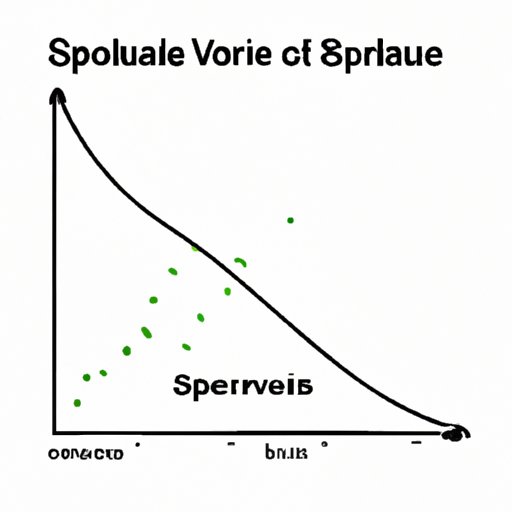Introduction
Slope is a fundamental concept in mathematics and has many real-world applications. Whether you are an engineer, architect, or scientist, understanding how to find the slope is an essential skill set. Slope is a measure of how steep a line is, and it can be used to calculate different variables such as speed, rate of change, and inclination. This article will explore the definition of slope, its significance, and how to find it using different methods.
Definition of Slope
Slope is defined as the ratio of the vertical change between two points on a line (rise) to the horizontal change between those points (run). It is represented by the letter ‘m’ in mathematical equations. Slope can be used to measure the steepness of a hill, the angle of a roof, the inclination of a ramp, or the speed of a moving object.
The ability to find the slope is essential because it helps in solving real-life problems such as calculating the rate of change in business, predicting the arrival time of a vehicle, or determining the angle at which a building should be erected.
Real-world Examples
The concept of slope can be easily understood by using real-world examples. For instance, consider walking up a hill. Even a slight increase in steepness can make it harder to ascend the hill, thereby increasing your fatigue. Similarly, a wheelchair user will find it easier to climb a ramp with a smaller slope than a steeper one. Understanding the slope can help engineers and architects design structures such as buildings, bridges, and roads that are stable and safe to use.
Slope Formula
The slope formula is the most common method used to find the slope between two points. It involves dividing the difference in the y-coordinates of the two points by the difference in the x-coordinates of the same points. This can be mathematically represented as:
m = (y2 – y1) / (x2 – x1)
Where x1 and y1 are the coordinates of the first point and x2 and y2 are the coordinates of the second point.
Let us take an example where we want to find the slope between two points (2, 4) and (6, 10).
m = (10 – 4) / (6 – 2)
m = 6 / 4
m = 1.5
The slope between two points (2,4) and (6,10) is 1.5.
Visual Method
The visual method of finding the slope involves plotting the points on a graph and calculating the slope from the graph. Consider the two points (3,5) and (1,3). We can plot these two points on the graph and draw a straight line passing through them. By drawing a right-angled triangle, we can calculate the slope of the line.
From the graph, we can see that the vertical change (rise) between the two points is 2, whereas the horizontal change (run) is -2. The negative sign indicates that the line is descending. Therefore, the slope between the two points is -1.
Positive vs. Negative Slope
The sign of the slope indicates whether it is positive or negative. A positive slope represents a line going up from left to right, while a negative slope represents a line going down from left to right. A slope of zero indicates that the line is horizontal.
Consider the function y = 2x – 3. The slope of this function is 2. This means that for every unit increase in the x-coordinate, the y-coordinate increases by two units in an upward direction.
On the other hand, if we consider the equation y = -2x + 3, the slope of this line is -2. This indicates that for every unit increase in the x-coordinate, the y-coordinate decreases by two units in the downward direction.
Solution Steps
Here is a step-by-step method for finding the slope:
- Determine the coordinates of two points on a line.
- Subtract the y-coordinate of the first point from the y-coordinate of the second point.
- Subtract the x-coordinate of the first point from the x-coordinate of the second point.
- Divide the difference in the y-coordinates by the difference in the x-coordinates to find the slope.
Let us take an example where we want to find the slope using the above method:
Points A and B have the coordinates (2, 9) and (4, 15), respectively.
- The coordinates of point A are (2, 9) and the coordinates of point B are (4, 15).
- The difference in the y-coordinates is 15 – 9 = 6.
- The difference in the x-coordinates is 4 – 2 = 2.
- The slope is 6 / 2 = 3.
The slope of points A and B is 3.
Tips and Tricks
Here are some tips and tricks to help you master the slope:
- Practice as many problems as you can to familiarize yourself with the slope formula and the concept of slope.
- Always double-check your work to avoid mistakes.
- Use graphs to visualize the slope, especially when you have difficulty picturing a line in space.
- Learn to recognize different slopes on a graph by looking at their orientation.
With these tips and tricks, finding the slope will become more comfortable and faster.
Conclusion
In conclusion, understanding how to find the slope is essential in many disciplines and has many practical applications. This article has provided a step-by-step guide to finding the slope, two methods for finding the slope, the difference between positive and negative slopes, and several tips and tricks to master this essential skill. By applying these techniques, you will be able to solve real-world problems and make informed decisions. Always remember to practice the skills learned to become proficient.
